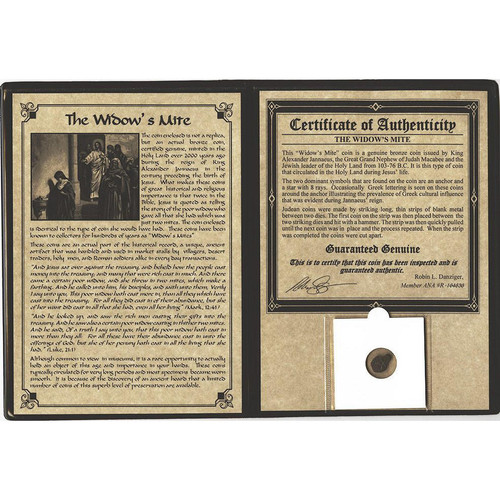Buy The Widow's Mite: Judean Prutah (103-76 BC) NGC Slab (PROMO) Coin Online
Widow’s Mite: Judean Prutah. Bronze prutah of Alexander Janeaus, king of Judaea, minted ca. 100 BCE. The ”widow’s mite“ mentioned in the Gospels of Mark and Luke - Jesus’ parable about a poor widow who gave ”two mites…all she had.“
Imagine holding a coin that dates back to the very time of Jesus' teachings! The Widow's Mite is not just a coin; it's a direct link to a powerful parable from the Gospels of Mark and Luke.
Overview of This Unique Collection:
- Historical Context: These bronze prutahs were minted during the reign of Alexander Jannaeus, king of Judaea, around 100 BCE. They are famously referenced in the New Testament when Jesus speaks of a poor widow who donates "two mites…all she had."
- Authenticity: Each coin is certified by NGC, ensuring its historical accuracy and authenticity.
- Condition: These coins, despite their age, are in remarkable condition, encapsulated in an NGC slab for protection and preservation.
Why Collect These Rare Coins?
Biblical Significance: This is the very coin type mentioned in Jesus' parable, making it a treasured artifact for collectors and historians alike. Historical Value: Minted during the reign of Alexander Jannaeus, these coins offer a glimpse into the economic and religious life of ancient Judaea. Certified Authenticity: Graded and authenticated by NGC, these coins are guaranteed to be genuine, adding credibility and value to your collection.
Highlights:
- Historical Importance: Directly connected to the teachings of Jesus, as mentioned in the Gospels of Mark and Luke.
- Authentic and Certified: Each coin is certified by NGC, guaranteeing its authenticity.
- Preserved Condition: Despite being over 2,000 years old, these coins are well-preserved in NGC slabs.
You may also like: indian head penny, 1955 P franklin half dollar, 1942-1945 War Nickel Roll, wheat penny roll, 90% mercury dime, 1964 Kennedy Half Dollar Roll.









